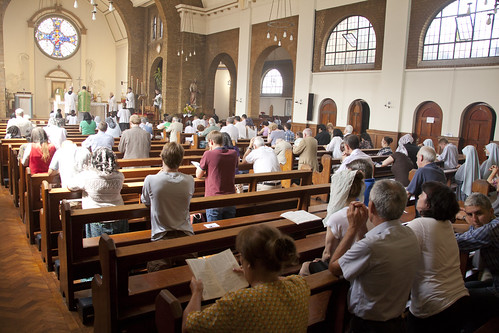 |
| A traditional Missa Cantata on a Sunday at St Bede's, Clapham Park |
Please send your observations to info@lms.org.uk with the Subject line 'Statistics'.
To illustrate what I want, here is my own report for this project.
In SS Gregory and Augustine's Church, Oxford, England, the 9:30am OF Mass on Sunday 19th April was attended (including clergy, servers, and singers) by 74 people: of whom 22 were male, and 11 under 17.
The 12 noon EF Mass in the same church on the same day was attended by 39 people, of whom 21 were male, and 12 under 17.
It may be helpful to indicate that this EF was a Missa Cantata which is celebrated monthly; the OF could best be described as 'conservative' (male altar servers, ad orientem, but in English).
From these numbers I can calculate that the proportion of men and children at the EF is far higher: 54% rather than 30%, and 30% rather than 15%.
Numbers fluctuate, local conditions vary, but the contrast between the two Masses I observed strikes me as fairly typical. The ratio between the sexes at the Ordinary Form in Oxford is close enough to a study, looking at the United States, which put the proportion of men in congreations at 37% back in 2005. It is an overwhelming, undeniable fact that the Novus Ordo is not attended by a healthy proportion of men.
And it is widely reported, and I don't think ever denied, that the Traditional Mass does get plenty of men, perhaps slightly more than half of a typical EF congregation being male, and that we also find plenty of children attending it. I've often heard priests say that the average age of their congregation crashes when they put on the Traditional Mass.
I could try to get a more accurate picture of this parish in England by counting the congregation of lots of Masses, but I'm not especially interested in this one parish: what I'd rather have is numbers from other parishes around the world.
I am also deeply interested in the number of young people at different Masses. However, I don't want to ask too much of my amateur researchers: I realise that I'm already asking them to count two congregations more than once, to get all the figures I want, and many congregations will be a lot larger than the one I was able to observe in this small church in England. And it is harder to define and identify 'young people'. If anyone wants to go the extra mile and provide numbers for 17 to 25 year-olds please do, but at the moment I'm focused on the more easily identifiable phenomenon of men and women, and of children.
What is the point of this research? To understand what is happening in the Church and how the liturgy makes a difference. A lot is being written about the sociology of the Traditional movement today with almost no meaningful empirical basis. It is still far too small to attract the attention of many professional sociologists of religion.
So, if you get the chance to do a count of your local Masses and how the congregations are composed, please send your observations to info@lms.org.uk with the Subject line 'Statistics'. And may God reward you for making the effort.